EY Puts People First: Navigating Growth with Human-Centric People Advisory Services
In early 2023, TBR met with EY’s Kim Billeter, Americas People Advisory Services leader, Jonathan Sears, Global People Advisory Services Technology leader, PAS US-East leader, and Simon Stanaway, Americas Mobility leader, to discuss progress EY has made in growing People Advisory Services (PAS) within a highly competitive market and during a pandemic. The following reflects that discussion, follow-up discussions and emails, as well as TBR’s ongoing assessment of EY and the broader consulting and IT services space.
For a few years EY has led engagements with the idea that “humans at the center” provides the best path to successful and sustained business transformations. For the firm’s People Advisory Services (PAS) practice, this approach has resonated well with clients, fueling an ambition that EY could be earning $5 billion by 2027 from advising clients on workforce and HR transformation as well as people experience and mobility.
As a practice that provides specific solutions to businesses’ talent management problems and incorporates a range of related services across the rest of EY’s offerings — as well as advising the firm’s own leadership on HR strategies and opportunities — EY PAS has steadily evolved from offering consulting-heavy services with complementary technology solutions to providing an extraordinarily comprehensive array of solutions and services, touching on — and accelerating time to value of — every aspect of talent within an organization. The full breadth of services and the depth of thinking through how every aspect of an enterprise can be positively changed through HR transformation necessitates focusing on a few elements.
Consistent, Steady Strategy — and Robust Results
In TBR’s discussion with Kim Billeter, Americas People Advisory Services leader; Simon Stanaway, Americas Mobility leader; and Jonathan Sears, Global People Advisory Services Technology leader, PAS US-East leader, some of the core principles around HR transformation and people management remained the same as when TBR met with EY PAS in October 2020:
- When digital transformations fail to meet expectations, it is not because the technology failed, but because the people did.
- For EY (or any similar consultancy) to serve its clients, the firm must combine a global mindset to address global clients’ cross-border issues (travel, tax, remote working) with local knowledge around culture and compliance.
- Almost every client transforms iteratively — one step at a time — so success breeds more success, and dashed expectations diminish chances of doing more transformations.
A few quick numbers on EY’s PAS business:
- 15,200 dedicated staff
- Over $2 billion in global revenue (in 2022)
- Will be part of the $10 billion investment EY has committed to “technology, sustainability, strategy, and audit” over the next three years, according to EY PAS leaders
Structurally, PAS includes four transformative solutions areas: Organization and Workforce Transformation, HR Transformation, People Experience, and People Mobility. Underpinning those areas are at least 16 components of an Org & People Platform, including digital assets such as the EY Skills Foundry, EY Global Payroll Strategy Accelerator, and EY Change Insights.
Turning to the business of PAS within EY, the firm’s leaders noted that while only 1% of PAS revenue currently comes from managed services contracts, the firm expects this figure to increase to 15% in the next five years. Consulting and systems implementation engagements currently contribute around 80% of PAS revenue — a figure that is projected to remain about the same in five years. “As a Service” commercial arrangements generate the remaining revenue.
In TBR’s view, expanding opportunities around managed services within PAS dovetails perfectly with the firm’s overall managed services strategy and reflects emerging buyer preferences for managed services pricing and contracts. EY’s PAS leaders also noted that geographic revenue splits have remained fairly constant over the last few years, with Americas around 44%, EMEIA at 39% and APAC the smallest at 17%.
TBR believes EY has the most comprehensive and structured set of offerings centered on what could be described broadly as people and workforce consulting. Big Four peers and HR-centric niche players may have more developed capabilities in specific areas, but no other firm combines an almost exhaustive range of offerings and solutions as neatly organized, managed and brought to market.
Inspire, Lead, Care, Empower, Build and Collaborate
During the discussion with TBR, EY PAS leaders stressed the importance they placed on leveraging research the firm conducted along with Oxford University, particularly their findings around “six levers [that] should be brought to life through deliberate design from the start and reflection on progress across all phases of” a successful business transformation.
Billeter explained that EY’s Transformation EQ approach could include immersive sessions — preferably at an EY wavespace — during which the client would assess current standing across the six levers: inspire, lead, care, empower, build and collaborate. Billeter and her colleagues stressed the criticality of coming back to all six levers “during the transformation journey” and described successful transformations as being more iterative than huge leaps forward.
TBR questioned whether these six levers could be used as stand-ins for KPIs to measure success across a transformation engagement. Billeter explained that EY’s “value isn’t hitting exact KPIs but getting” to a successful transformation faster and using iterative changes to continually set up the client for the next transformation. TBR has frequently heard HR and digital transformation consultants stress various aspects embedded in EY’s six levers, usually with a heavy emphasis on the approach or idea that resonates most with that consultant’s strength.
With EY’s approach, TBR sees a more comprehensive thinking through of every aspect of change — from “clearly communicate to people why change is needed” to “use technology to quickly show what the vision means” to “work with the influencers in the workforce to cocreate new ways of working.” This approach, based on research and EY’s experience, also keeps humans at the center.
The Currency of the Future
EY PAS leaders discussed the firm’s People Mobility practice, starting with an ambition to reach $1.5 billion in annual revenue by 2027 across Immigration, Core Mobility, and Mobility Managed Services, building on a base of around $1 billion over the last year. The leaders noted fast growth in the Immigration practice and a desire to move more engagements toward Mobility Managed Services, echoing the larger firm’s overall managed services strategy.
In addition, the EY Mobility Pathway solution now has more than 1,000 clients, up from just 140 when EY PAS leaders briefed TBR in October 2020. Within the Organization & Workforce Transformation practice area, Billeter said the EY Skills Foundry platform, in collaboration with around 30 technology partners, had resonated with clients’ “number one [talent management] concern: align and future-proof skills,” which Billeter described as the “currency of the future.”
In TBR’s research around learning and development programs, few consultancies have consistently migrated their own training success to clients’ environments. If EY PAS can continue building on its early adoption by clients of EY Skills Foundry — particularly if the firm expands the kinds of clients into new verticals and develops a broad, but applicable, set of upskilling and reskilling training — this could become a vital anchor into clients’ talent management leaders and provide EY with additional insights into how clients are changing and what consulting and technology needs may be on the near horizon.
Reflecting on an initiative that attracted considerable EY leadership attention pre-pandemic, TBR asked about the current state of badges, an internal program to upskill and reskill professionals using training to become proficient in specific technologies, services, or related subjects. Absent frequent marketing mention of badges, TBR wondered if the effort had fizzled out.
Quite to the contrary, according to EY PAS leaders, who explained that, “Our badges program has gone from strength to strength in PAS, with over 13,500 badges awarded to PAS professionals globally since the Badge program’s inception, over 2,800 of them earned this fiscal year [July 2022 to now]. We have broadened our badge offering to our people to ensure they have the opportunity to upskill in areas that are directly relevant to their roles, such as Analytics, Design Thinking, Inclusion and Belonging and Sustainability, as well as heavily in demand future-focused technology skills in the market like Cloud and Quantum Computing.”
EY PAS leaders continued, adding that, “PAS also has a curated path to both the Tech MBA and the Sustainability MBA that we offer through Hult University, ensuring our people can see an achievable path through their work to this qualification. PAS has even created our own Change Management badge in partnership with Hult under the Transformation subdomain, which is owned and curated by our global leadership, and in its first year we’ve had 1,523 completions, and another 2,771 people initiate the badge.”
In TBR’s view, EY’s sustained commitment to this effort reinforces EY’s “humans at the center” ethos. Aside from financial compensation, few job elements rank higher for most employees than continued professional development and consistent recognition for work well done. Badges may have seemed like a simple gamification of learning and development when EY launched the program, but continuing to invest in and evolve badges demonstrates a substantial commitment to its people.
Powering Transformation Through Granularity
In a special session with Sears, TBR asked about EY’s Organization & Talent Hub (OTH), a SaaS-like offering that seemed, at first glance, to be more about EY’s technology than its consulting expertise. Sears set TBR straight. The OTH is a suite of “cloud-based tools to enable real-time access to data and insights to accelerate workforce decisions,” but is not sold through a SaaS engagement, although the EY proprietary software does stay with the client.
Sears explained that EY uses a variety of tools to scan a client’s various IT and organizational layers, scan client data, and then model out various scenarios on potential future states of the organization. According to Sears, the OTH suite “offers the granularity necessary for forecasting workforce needs, planning the new organization, selecting and retaining talent, while tracking workforce movements as plans are implemented.”
While OTH is unquestionably a software-enabled solution, Sears stressed the consulting underpinning every OTH deployment and added that the firm has seen success incorporating OTH into M&A consulting engagements. Like the rest of EY’s PAS portfolio, OTH is extraordinarily comprehensive: the governance elements alone implicate an enterprise’s transformation management office as well as HR, operations, finance and IT functions. In reviewing Sears’ presentation and reflecting on the discussion, TBR can confirm EY has seemingly thought of every angle needed to “power … organization restructuring, talent realignment, and cost-savings visibility.”
What Is and What Will Be
Based on the extensive discussions with EY PAS leaders, including a recent session on the implications of generative AI, TBR will be watching three developments over the next year:
- EY’s Skills Foundry could set the standard to address growing demand for knowledge development in emerging technologies. Skills is the “currency of the future,” compelling EY and its Big Four peers and other competitors to focus on delivering around clients’ skills development, including measuring progress, recalibrating learning and development initiatives, and maintaining trust. In TBR’s Digital Transformation Voice of the Customer research, consulting clients have increasingly called for more assistance bringing their own people up to speed on emerging technologies, enabling the clients to fully leverage the technologies they purchase.
- In-person immersive workshops return to set the stage for transformation initiatives. HR professionals have been perhaps the most stressed and overworked knowledge management employees in the past three years (an exaggeration? Consider the rush to all-remote working at the start of the pandemic, then back-to-office policies, followed by spiking attrition, and now a wave of tech sector layoffs, all managed by HR professionals). If any group deserves a couple days of understanding the art-of-the-possible in an off-site setting — maybe seeing the intricacies of the OTH — it is HR professionals. TBR anticipates a resurgence of investments in physical spaces for innovation and iterative transformation sessions, even if the 2023 wave does not match the pre-pandemic tsunami.
- The focus on cost combined with AI and automation will severely challenge enterprises’ efforts to build employee loyalty. EY PAS may find a need to subtly position its value proposition around sustaining trust — across employees, leaders, and even ecosystem partners — as everyone worries about their own value in an AI future.
According to TBR’s 4Q22 Global Delivery Benchmark, which tracks 14 IT services vendors’ resource management strategies: “Finding bright spots that are not simply tactical and short term, but rather facilitate a long-term transition toward becoming a platform-enabled business in times of crisis, has compelled vendors to double down on their investments in AI. For a while, vendors’ AI investments have been largely geared toward adding skills and capabilities in areas such as data science and data engineering through acquisitions, as it remains highly ineffective for vendors to invest in and groom AI-ready talent internally. At the same time, there are many business decisions that depend on more than just managing structured data. To extract the most value from AI investments, vendors must consider addressing the economies of change management internally and offering it ‘as a Service’ while taking incremental steps toward adopting sophisticated automation systems such as GenAI.
“Carefully integrating AI skills and IP will be critical to vendors’ ability to secure future investments. As buyers expect GenAI to help them generate better customer insights and improve employee productivity, vendors must carefully manage buyer expectations, as simply adding another, more sophisticated technology to a broken process will likely skew results.”
One final note: EY’s PAS practice may be one of the biggest beneficiaries of the firm’s decision to forgo a split (see the upcoming TBR special report on the end of Project Everest). EY PAS leaders repeatedly told TBR that PAS professionals work across all of the firm’s practices and benefit from doors opened by colleagues in EY’s strategy consulting, tax, audit and cybersecurity practices. In TBR’s view, the firm’s ability to pull together a truly holistic set of services for enterprise clients strengthens EY’s brand and value. And if humans are at the center, PAS is at the center of that value proposition.



 Technology Business Research, Inc.
Technology Business Research, Inc.
EY’s Cybersecurity Practice: Global, Local and Trusted
/by Patrick Heffernan, Practice Manager and Principal AnalystIn TBR’s view, EY continues to operate through a global effort, complicated by regulatory and compliance requirements that vary by country as well as member firms’ different partnership structures. However, at multiple times during the discussion, EY leaders said the firm knew that cybersecurity services required being “local to be there with clients.”